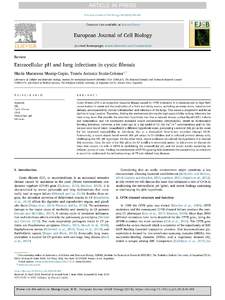Please use this identifier to cite or link to this item:
https://repositorio.uca.edu.ar/handle/123456789/8916| Título: | Extracellular pH and lung infections in cystic fibrosis | Autor: | Massip Copiz, María Macarena Santa Coloma, Tomás Antonio |
Palabras clave: | GENES CFTR DEPENDIENTES; FIBROSIS QUISTICA; PH; PULMONES; ENFERMEDADES; INFECCIONES | Fecha de publicación: | 2018 | Editorial: | Elsevier | Cita: | Massip-Copiz MM, Santa-Coloma TA. Extracellular pH and lung infections in cystic fibrosis [en línea]. European Journal of Cell Biology. 2018;97(6):402-410. doi:10.1016/j.ejcb.2018.06.001 Disponible en: https://repositorio.uca.edu.ar/handle/123456789/8916 | Resumen: | Abstract: Cystic fibrosis (CF) is an autosomal recessive disease caused by CFTR mutations. It is characterized by high NaCl concentration in sweat and the production of a thick and sticky mucus, occluding secretory ducts, intestine and airways, accompanied by chronic inflammation and infections of the lungs. This causes a progressive and lethal decline in lung function. Therefore, finding the mechanisms driving the high susceptibility to lung infections has been a key issue. For decades the prevalent hypothesis was that a reduced airway surface liquid (ASL) volume and composition, and the consequent increased mucus concentration (dehydration), create an environment favoring infections. However, a few years ago, in a pig model of CF, the Na+/K+ concentrations and the ASL volume were found intact. Immediately a different hypothesis arose, postulating a reduced ASL pH as the cause for the increased susceptibility to infections, due to a diminished bicarbonate secretion through CFTR. Noteworthy, a recent report found normal ASL pH values in CF children and in cultured primary airway cells, challenging the ASL pH hypothesis. On the other hand, recent evidences revitalized the hypothesis of a reduced ASL secretion. Thus, the role of the ASL pH in the CF is still a controversial matter. In this review we discuss the basis that sustain the role of CFTR in modulating the extracellular pH, and the recent results sustaining the different points of view. Finding the mechanisms of CFTR signaling that determine the susceptibility to infections is crucial to understand the pathophysiology of CF and related lung diseases. | URI: | https://repositorio.uca.edu.ar/handle/123456789/8916 | ISSN: | 0171-9335 | Disciplina: | MEDICINA | DOI: | 10.1016/j.ejcb.2018.06.001 | Derechos: | Acceso abierto | Fuente: | European Journal of Cell Biology. 2018;97(6):402-410 |
| Appears in Collections: | Artículos |
Files in This Item:
| File | Description | Size | Format | |
|---|---|---|---|---|
| extracellular-ph-lung-infections.pdf | 544,5 kB | Adobe PDF |  View/Open | |
| extracellular-ph-lung-infections.jpg | 814,79 kB | JPEG |  View/Open |
Page view(s)
195
checked on Apr 30, 2024
Download(s)
553
checked on Apr 30, 2024
Google ScholarTM
Check
Altmetric
Altmetric
This item is licensed under a Creative Commons License

